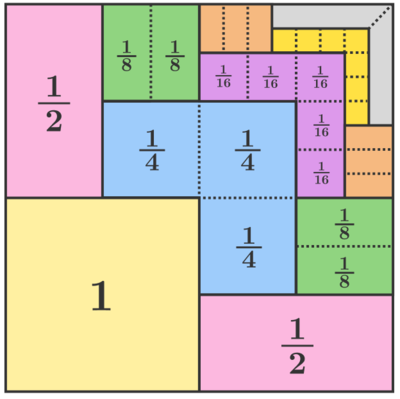Proof Without Words

What algebraic identity is this?
This section requires Javascript.
You are seeing this because something didn't load right. We suggest you, (a) try
refreshing the page, (b) enabling javascript if it is disabled on your browser and,
finally, (c)
loading the
non-javascript version of this page
. We're sorry about the hassle.
3 solutions
It's a great picture, though I don't think I would call it a "Proof Without Words".
Log in to reply
Do you need an explanation with this one too? Proof Without Words-Part 6
dirty proof
Log in to reply
no, not a dirty proof. It's a clean proof. As clean as proofs go.
Let S=1+2(1/2)+3(1/4)+4(1/8)+.............
and
S1=1+1/2+1/4+1/8+1/16+...........
and
S2=1/2+2(1/4)+3(1/8)+4(1/16)+..........
since S1+S2=S
and S2=1/2+2(1/4)+3(1/8)+4(1/16)+..........=1/2[1+2(1/2)+3(1/4)+4(1/8)+.............]=1/2(S)
Therefore, S1+S2=S implies, S=2*S1=2[1+1/2+1/4+1/8+1/16+...........]=2[1/(1-1/2)]=4
and pictorially, 4x1=4.
Hence Proved.
Since one forth of total area=1,so the total area=4*1=4 though we can calculate many interesting ways.
The figure suggests that it's a 2 x 2 square with an area of 4 . Assuming this, we can see how there's 1 tile with an area of 1 , 2 tiles each with an area of 2 1 , 3 tiles each with an area of 4 1 , etc. These comments have been added otherwise Brilliant.org sends the solution back "for more and better explanation".